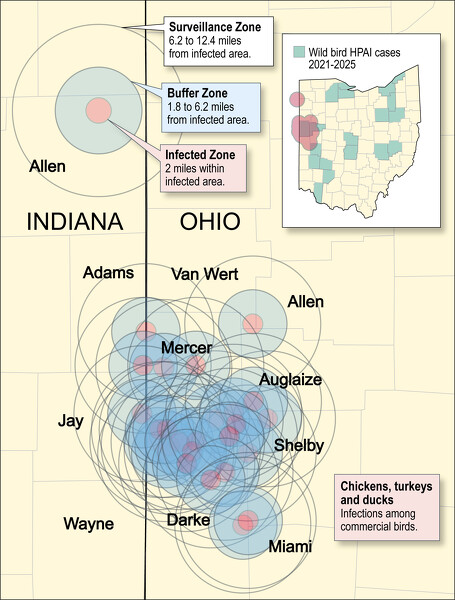
High Path Avian Influenza (HPAI) in the Grand Lake region.
SOURCES: Ohio Department of Agriculture, USDA, National Wildlife Health Center, U.S. Geological Survey
CELINA- The influx of High Path Avian Influenza (HPAI) in the Grand Lake region can be attributed to a group of dead Canada geese found dead near Grand Lake in December 2024, with additional wild birds with HPAI suspected in other areas of the state.
HPAI, commonly known as bird flu, is a contagious viral disease that poses a major threat to the poultry industry and animal health.
The Grand Lake region has emerged as the hotbed of an outbreak of HPAI in Ohio, with more than half Mercer County's commercial bird inventory destroyed since the start of 2025, based on numbers from the USDA's 2022 Agriculture Census.
ODA Director Brian Baldridge previously told The Daily Standard that his department has been on high alert since December when the group of dead geese were found.
"As we work through high path (HPAI), we know that migratory birds are the culprit," Baldridge had said. "Wild birds are the culprit of spreading and we know that this is a time of year where a lot of birds, especially geese, are moving. We had a die off of some geese at Grand Lake … that happened in the first part of December. It was a trigger and a red flag that went up for us."
ODNR Division of Wildlife has received only the one positive confirmation from the National Veterinary Services Laboratory (NVSL) for positive HPAI in a Canada goose from Mercer County, ODNR Media and Outreach Specialist Karina Cheung said.
But HPAI is suspected in a number of counties in Ohio.
"We are currently awaiting more test results from the National Veterinary Services Laboratory on several samples," Cheung added. "Samples for testing are sent to the Ohio Department of Agriculture. The samples that receive a presumptive positive result are sent to the National Veterinary Services Laboratory for official confirmation."
From 2024-2025, Cheung said ODNR has sent in the following wild birds for testing: Canada goose, mallard, crow, trumpeter swan and red-shouldered hawk.
Wild birds can be infected with HPAI and show no signs of illness, according to the USDA website. The birds carry the disease to new areas when migrating, potentially exposing domestic poultry to the virus.
Although HPAI can affect bald eagles, Cheung maintained that ODNR has not received any reports of dead bald eagles in the Grand Lake region this winter.
Bird feeders are unlikely to result in increased spread of HPAI because the species of birds that tend to come to feeders are not commonly infected, per Cheung.
ODNR advises those with bird feeders should take common-sense precautions after handling their feeders, including washing their hands with soap and water, routinely disinfecting feeders and avoiding contact with bird excrement.
The group of dead Canada geese found in Mercer County kicked off a litany of HPAI detections in area commercial poultry facilities.
There have been 61 bird flu detections at commercial poultry facilities in Ohio this year. There have been 40 in Mercer, 18 in Darke, two in Auglaize and one in Van Wert, affecting 11,103,221 commercial birds.
As of Sunday, bird flu has led to the destruction of 5,818,964 commercial birds in Mercer County, which would be 66.1% of the county's commercial inventory of 8.8 million turkeys, layers, pullets and broilers, according to USDA's 2022 Ag Census.
In addition, a farm worker in Mercer County tested positive for the virus last week after being exposed to dead commercial poultry.
The CDC considers the current risk of bird flu for the general public to be low. However, people with close and prolonged contact with infected birds are at greater risk, according an Ohio Department of Health news release. Farm workers, veterinarians and those who may have close contact with infected birds or other animals should take extra precautions.
ODNR Division of Wildlife continues to monitor all reports of dead wild birds in Ohio.
The Division of Wildlife asks people to call 1-800-WILDLIFE or 1-800-945-3543 and report sightings of dead birds in groups of more than six.


